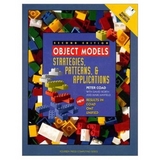
Object Models
Prentice Hall
978-0-13-108614-2 (ISBN)
- Titel erscheint in neuer Auflage
- Artikel merken
Object programmers can now learn how to get faster results using the strategies and patterns (templates) uncovered in this book. Without them, however, the much-needed expertise is only acquired by trail-and- error. Using sufficiently detailed, real-life examples, this book/disk package shows how to build effective object models-using applications that occur in nearly every industry. Presents six chapter- length application examples of how effective, real-life object-models are build-e.g., point-of-sale, warehousing, order-processing, data acquisition and control, and sensors and diverters. Each application reveals specific "how-to" strategies (101 total) and patterns (22 total) that will help readers develop an intuitive feel for building object models. The diskette features an on-line verison of the strategies and patterns summary (in the form of a Windows help file); as well as C++ course files, illustrating a reasonable (but not the only way) to implement each pattern.
Acknowledgements xi. Preface xii. Applications xiii. Strategies and Patterns xiv. Why read this book? xv. Automated Tool, Included on Disckett xvi. Additional Strategies and Patterns xvii. Creativity and Innovation xviii. 1. Connie's Convenience Store (A Point-of-Sale Application). Getting Started 1. In This Chapter 1. Identifying System Purpose and Features 2. Selecting Objects 5. Selecting Problem-Domain Objects 7. Applying Patterns: Select and Organize Problem-Domain Objects 18. Establishing Responsibilities For Problem-Domain Objects 29. Applying Patterns: Establish Problem-Domain Responsibilities 55. Working Out Problem-Domain Dynamics With Scenarios 60. Selecting Human-Interaction Objects 66. Establishing Human-Interaction Responsibilities 69. Working Out Human-Interaction Dynamics With Scenarios 72. Selecting System-Interaction Objects 81. Establishing System-Interaction Responsibilities 83. Working Out System-Interaction Dynamics With Scenarios 85. Selecting Data- Management Objects and Responsibilities 86. Working Out Data-Management Dynamics With Scenarios 88. Progress At This Point 90. Wrap-Up 96. 2. Wally's Warehouse (A Warehouse Application) 97. Identifying System Purpose and Features 98. Identify System Features 101. Selecting Problem-Domain Objects 101. Applying Patterns: Select and Organize Problem-Domain Objects 105. Establishing Responsibilities For The Problem-Domain Objects 114. Working Out Problem-Domain Dynamics With Scenarios 128. Selecting Human-Interaction Objects and Responsibilities 133. Working Out Human-Interaction Dynamics With Scenarios 134. Selecting Data-Management Objects and Responsibilities 142. Selecting System-Interaction Objects and Responsibilities 143. Progress At This Point 143. Wrap-Up 149. 3. Ollie's Order Center (An Order-Entry Application) 151. Getting Started 151. Identifying System Purpose and Features 152. Selecting Objects 156. Selecting Problem-Domain Objects 158. Reuse, Reuse, Reuse 160. Establishing Responsibilities For Problem-Domain Objects 165. Working Out Problem-Domain Dynamics With Scenarios 182. Selecting Human- Interaction Objects 183. Establishing Human-Interaction Responsibilities 184. Working Out Human-Interaction Dynamics With Scenarios 185. Selecting System Interaction Objects 187. Establishing System-Interaction Responsibilities 188. Working Out System-Interaction Dynamics With Scenarios 189. Selecting Data-Management Objects and Responsibilities 189. Working Out Data-Management Dynamics With Scenarios 190. Progress At This Point 192. Wrap-Up 196. 4. Dani's Diverters (A Soft Real-Time Conveyance Application) 197. Identifying System Purpose And Features 197. Activities, Activities, Activities 202. Selecting Problem-Domain Objects 203. Applying Patterns: Organize Problem-Domain Objects 207. Working Out Problem-Domain Dynamics With Scenarios 211. Selecting Human Interaction Objects 222. Selecting System-Interaction Objects 223. Selecting Data-Management Objects And Responsibilities 224. Establishing Responsibilities 224. Real-Time System Considerations 230. Progress At This Point 238. Wrap-Up 241. 5. Andi's Autopilot (A Hard Real-Time Control Application) 243. Identifying System Purpose And Features 243. Selecting Objects 244. Selecting Problem-Domain Objects 250. Working Out The Model 257. Working Out Problem-Domain Dynamics With Scenarios 266. Selecting Human- Interaction Objects 281. Establishing Human-Interaction Responsibilities 281. Working Out Human-Interaction Dynamics With Scenarios 281. Selecting Data-Management Objects 282. Selecting System-Interaction Objects 282. Establishing System-Interaction Responsibilities 282. Working Out System- Interaction Dynamics With Scenarios 283. Progress At This Point 284. Wrap-Up 288. 6. All Five Applications, At High Speed 289. The Power Of Patterns 289. Patterns, Supported by Strategies 290. Connie's Convenience Store (A Point-of-Sale Application) 291. Wally's Warehouse (A WAREHOUSE APPLICATION) 309. Ollie's Order Center (An Order-Entry Application) 335. Dani's Diverters (A Soft Real-Time Application) 359. Andi's Auto-Polot (A Hard Real-Time Application) 368. Wrap-Up 380. Congratulations! 380. 7. Strategies And Patterns Handbook 381. Strategies For Building Object Models 381. Patterns For Building Object Models 422. Epilog 447. A Notation 451. Critical Success Factors 451. The Icons 451. The Connections 453. A Business Example 454. A Real-Time Example 456. Scenario Views 456. Object-Model Components 459. Other Notations, Not Included (And Why) 460. Wrap-Up 462. B. Patterns In Other Fields 463. C. Data Management 471. DM Objects: What, When, Why 471. PD And DM Objects 472. HI And PD Objects 472. Details On DM Objects 472. Implementation Notes 476. WRAP-UP 479. D. The Executive Decision to Adopt Object Technology 481. Significant Improvements With Object Technology 481. Why Executives Adopt Object Technology 484. How To Get Started With Object Technology 485. E. A Histogram of Initial Object Modeling 489. Glossary 491. Bibliography 497. Software Development 497. Patterns In Other Fields 498. Other Publications 498. Related Publications By The Authors 498. Index 499.
| Erscheint lt. Verlag | 23.3.1995 |
|---|---|
| Verlagsort | Upper Saddle River |
| Sprache | englisch |
| Maße | 208 x 262 mm |
| Gewicht | 1220 g |
| Themenwelt | Mathematik / Informatik ► Informatik ► Programmiersprachen / -werkzeuge |
| Informatik ► Software Entwicklung ► Objektorientierung | |
| ISBN-10 | 0-13-108614-6 / 0131086146 |
| ISBN-13 | 978-0-13-108614-2 / 9780131086142 |
| Zustand | Neuware |
| Haben Sie eine Frage zum Produkt? |
